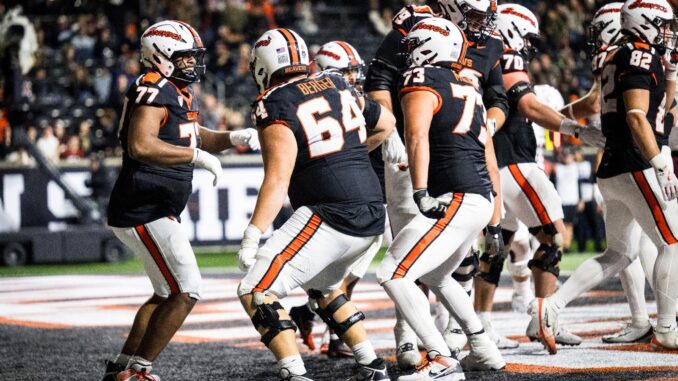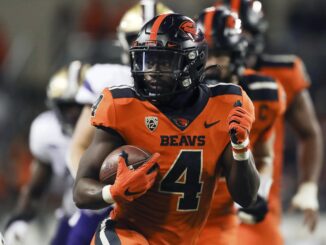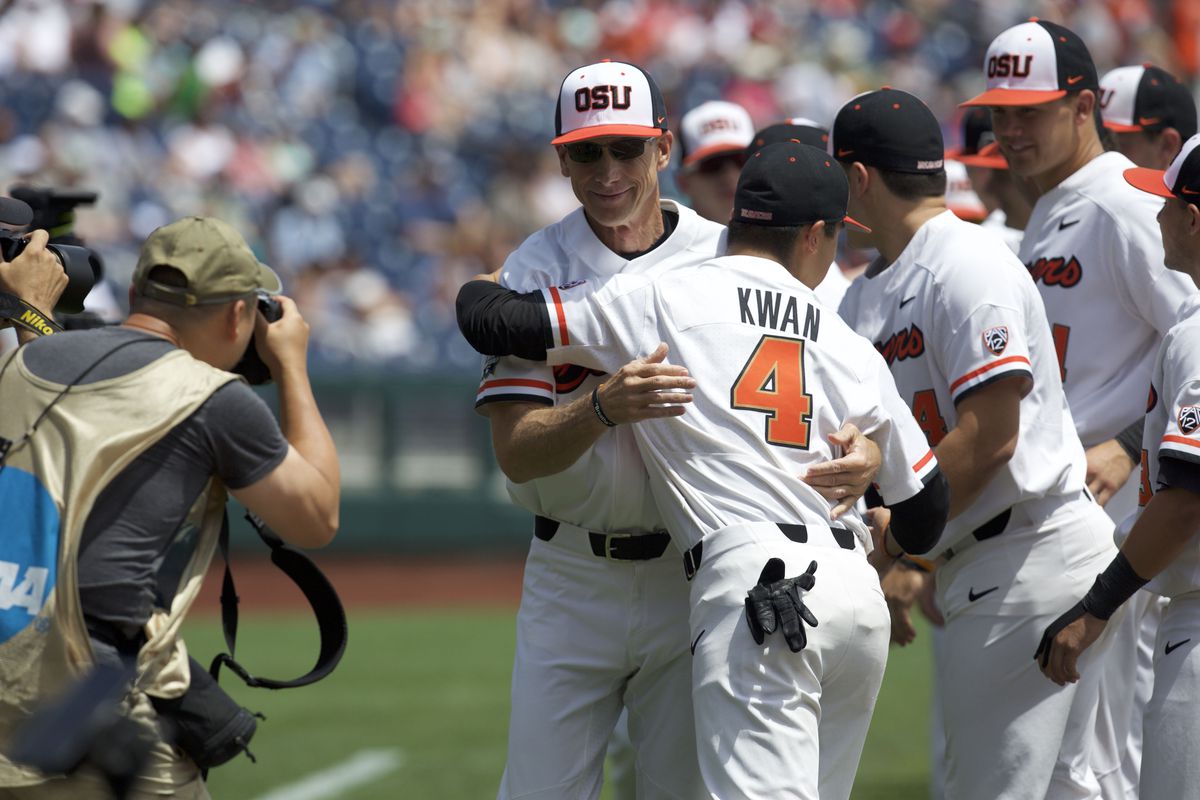
When it’s cloudy for nights on end, we can’t see the stars. That doesn’t mean they aren’t there; it just means we haven’t seen them.
Such is the case in Corvallis, where the Oregon State Beavers haven’t produced stars that are easily seen. But with a new coach, the forecast in Corvallis is changing, and new stars are emerging. Some have been veiled on the bench, knowing they have star power but willing to wait their turns.
Bob Marley once said, “When I was rich, they gave me the star treatment. But, I was just as good when I was poor.”
This week, Washington State (4-4) comes to Corvallis to challenge the relaunch of the Oregon State (1-7) football team under new interim coach Rob Askey.
What are the chances Oregon State can pull off an upset, and who are the stars who will shine through what have been some cloudy days?
Washington State has been an enigma; a cauldron of unexpected highs with iceboxes of perplexing lows.
The Cougars began the season with a three-point win over 3-5 Idaho from the lower FCS division. So desperate was the WSU situation that it took a field goal with no time left to secure a win.
The following week, Washington State delivered a resounding 36-13 whipping of San Diego State, which is currently 6-1.
The Cougars then lost two games by a combined 118-34 to opponents that are still unranked.
From that icebox, they heated up and lost by three or fewer points to #7 Mississippi and #15 Virginia.
The anomalies are also evident on critical plays: the Cougars are in the bottom quadrant for converting third downs, yet in the top quadrant for converting fourth downs.
The question is: Which Cougar team will show up this week?
Cougar quarterback Zevi Zeckhaus is also a bit of an anomaly. He’s terrific in the red zone, where he leads the Cougars to one of the highest success rates in the country.
The problem is, he can’t get there. The Cougar offensive line ranks 129th in run blocking, which has made it hard to move the ball and reduced red-zone appearances.
That offensive line might find things easier this week because Oregon State has been porous against the run.
If WSU gets to the red zone, Oregon State will have to keep a spy on WSU quarterbacks because they are particularly effective in rushing for touchdowns.
The same can’t be said for Cougar running backs who have combined for just two rushing touchdowns all season.
Another red-zone threat for Washington State is kicker Jack Stevens, who has missed only one field goal this year.
Washington State’s passing attack is inconsistent.
The Cougars started with Jaxon Potter at quarterback. He completed a high percentage of his passes (70.5%), but he threw an interception that was 45% above average.
WSU switched to Eckhaus as the starter. It seems odd to me that his completion percentage is less than Potter’s and his interception rate much higher, yet he has retained the starting position.
I don’t believe interception problems at WSU are primarily the fault of the quarterbacks.
Why?
Well, neither Jaxon nor Eckhaus had high interception rates in high school, and neither had high interception rates at previous colleges before transferring to WSU. I believe that points to systemic or technique inadequacies that fall on coaches to solve.
The Cougars have a hidden star of their own in freshman receiver Carter Pabst. With speed and elusiveness, Pabst has shown the potential to be one of the premier long-ball receivers in college football. He has nearly twice the yards per reception as WSU’s top two receivers, and he has the third most receiving yards despite being ninth in the number of times he’s been targeted.
He has more star power than he’s had opportunities.
Oregon State quarterback Gebari Johnson knows what that is like.
The Tacoma native and former four-star recruit waited a year and a half before getting a solid opportunity at Oregon State.
When he did, he carried the Beavers to their first win. Yes, that was against Lafayette from the FCS program, but the Leopard program is pretty good—good enough to lead OSU at the half.
Then, Johnson took over, and the Beavers exploded for 35 points in the second half. He rushed for 14 yards per attempt, and he completed eight of his nine passes. Unfortunately, one of those completions was to a Leopard.
Can he continue to emerge against a Washington State defense that is average when it comes to defending the run and horrible when it comes to defending the pass?
Improvement of the OSU offensive line is one reason to think he can.
Six weeks ago, Oregon State’s OL ranked 74th in my savvygameline.com metrics. Today, that ranking is 49th, an impressive improvement and a clear demonstration of the hard work and effectiveness of line coach Mike Cavanaugh.
Oregon State will have the best receiver on the field in Trent Walker, who averages six receptions per game, although none have resulted in a touchdown.
Anthony Hankerson has carried the ball more than most running backs in America. Like Trent Walker, he has volume, but his 4.36 yards per carry doesn’t affirm great effectiveness.
I commented last month that Oregon State’s 95% reliance on Hankerson to carry the ball was a problem.
But that has since changed as Beaver coaches have given true freshman running back Cornell Hatcher, Jr. some carries.
Hatcher has always been a star, and now, the nation is beginning to see it.
Against 29th-ranked Houston (7-1) earlier this month, Hatcher came off the bench to lead Oregon State in rushing (93), yards-per-carry (5.5), and rushing touchdowns (1).
In the past two games, Hatcher has carried the ball 22 times for 156 yards. That amounts to 7.1 yards per carry, which equates to star power among running backs.
As a team, Washington State has been unspectacular statistically, yet the enigmatic Cougars have somehow found a way into the top 20 on savvygameline.com for teams that have surpassed expectations.
Can they keep the enigma working? Oddsmakers think so, as they have assigned Washington State a 3.5-point spread over Oregon State.
My savvygameline.com system says it will be WSU, 33-21.
I disagree with my system’s 12-point margin. I think the final will be greater than 3.5 of the betting lines and less than 12 points by Savvy.
I disagree with my own system. It operates on its own, and so does my opinion. It’s my job to explain it, but that doesn’t mean I always agree with it.
I’ve said it before, I’m no ordinary dummy. I’ve got some wits about me.
For example, last year I found a puzzle that said, “3-5 years.”
I finished it in 18 months.
As the forecast in Corvallis changes, interim coach Robb Askey might be seen as a potential full-time head coach. Although that would be convenient, it wouldn’t be wise since he was 20-50 as a head coach in the FCS.
Hiring from within for the sake of convenience is sometimes like trying to save your sinking boat by carving drain holes in the bottom because your Swiss knife is just so convenient.
Through nine weeks of the 2025 season, my savvygameline.com system is 447-133 in predicting winners. It is 26 games better than betting lines in predicting point spreads and 11 games better in predicting total game points.
Last week, Savvy’s top three predictions were:
C Michigan 35-14 – final was 38-13
Baylor 40-21 – final was 41-20
Troy 34-20 – final was 35-23
To see all 52 college football game predictions this week, click here.




